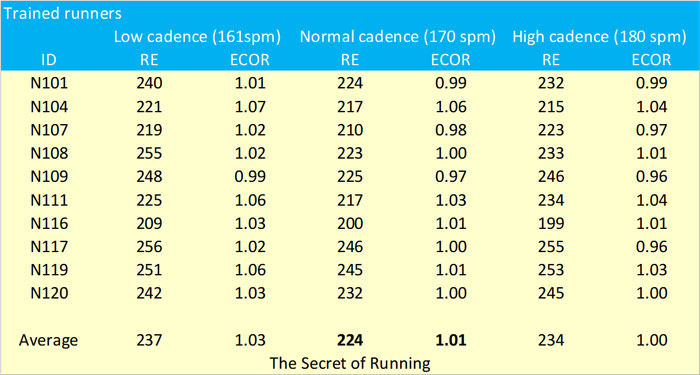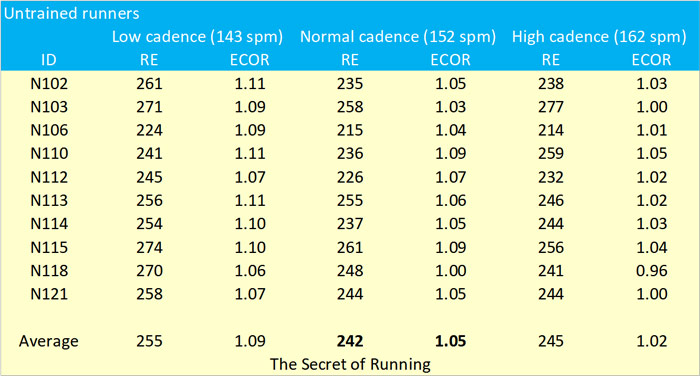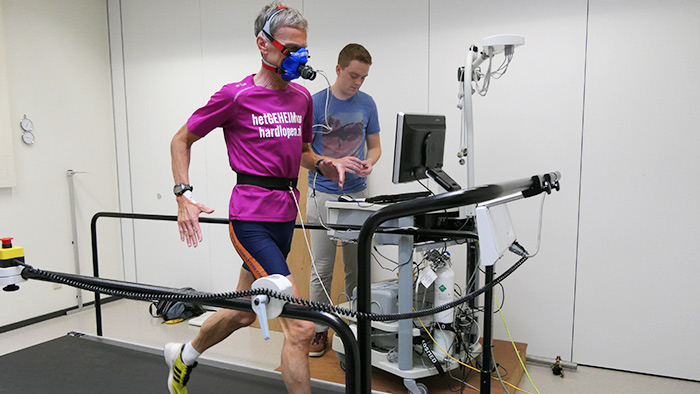Running cadence is a very interesting aspect of the running form as it can be easily measured with running watches, pods and smartphones. This opens the opportunity for runners to experiment with different cadences to find an optimum.
Many authors, coaches and runners believe that a higher cadence usually improves running form, running economy and performance. A cadence of at least 180 steps per minutes is frequently mentioned as goal, but this number may vary for individual runners.
Recently, we investigated the impact of cadence experimentally in the physiological laboratory of Professor Maria Hopman at the Radboud University of Nijmegen (RUN), the Netherlands. A full scientific paper on the project has been submitted to the Journal of Sports Sciences and Medicine.
In order to share our results with the running community at large, we have written four short, popular papers on the main findings, which can be downloaded from our website, The Secret of Running. These four papers investigate:
- The (close) relationship between Stryd power and VO2
- The impact of speed on the running economy (ECOR and RE)
- The impact of cadence on the running economy (ECOR and RE)
- The physiological differences between trained and untrained runners
This article will look at the impact of cadence on running economy. The pictures below show the authors during the treadmill tests as well as some of the laboratory equipment at RUN. The left picture also shows the primary investigator, MSc-student Rick Sniekers.
Trained runners need less power as well as less oxygen than untrained runners
The project included measuring simultaneously the VO2 (in ml O2/kg/min) and the Stryd power (in Watt/kg) of 21 runners (11 trained and experienced distance runners and 10 untrained students) at a moderate speed (lactate threshold minus 2 km/h).
All runners first ran for three minutes at their self-selected cadence, followed by three minutes at a 10 steps per minute higher cadence (the runners were assisted in doing this by a metronome) and finally three minutes at a 10 spm lower cadence. This means that we got a total of 21*3 = 63 data of VO2 and power.
From the power data, we calculated the mechanical Energy Cost of Running (ECOR) with the formula:
ECOR (kJ/kg/km) = P (Watt/kg)/v (m/s)
From the VO2 data we calculated the oxygen cost of running, commonly referred to as the Running Economy (RE) with the formula:
RE (ml O2/kg/km) = 60/3.6*VO2 (ml O2/kg/min)/v (m/s)
We have summarized the results for the two groups and the different cadences in the table below.
One of the most striking findings is that trained runners were consistently more economical than untrained runners, both in terms of the mechanical energy (ECOR) as well as the oxygen consumption (RE).
At the self-selected cadence, the average RE of untrained runners was 242 ml O2/kg/km which was 8 percent higher than the average RE of the trained runners (224 ml O2/kg/km). The average ECOR of the untrained runners was 1.05, which was 4 percent higher than the average for the trained runners (1.01 kJ/kg/km). Based on these results, we hypothesize that training may result in two important benefits:
- The running technique improves, which explains the 4 percent lower ECOR
- The metabolic efficiency (ME) improves, which explains the even greater reduction of the RE (8 percent)
We note that the self-selected cadence of the trained runners (170 spm) was significantly higher than that of the untrained runners ((152 spm). It is intriguing to question to what extent this difference might relate to the observed differences in RE and ECOR.


ECOR declines consistently with cadence, RE is usually best at the self-selected cadence
Next to the big difference between untrained and trained runners, the tables show the momentary impact of the deliberate changes in cadence.
As cadence increases, the ECOR reduces slightly but consistently. For trained runners the reduction is 3 percent, for untrained runners it is bigger (7 percent). This reduction of ECOR is probably related to the reduction in vertical oscillation, which occurs simultaneously when cadence is increased at the same speed.
Regarding RE, the impact is less consistent. A lower cadence always leads to an increase in RE, but a higher cadence does not always lead to a decrease in RE. This complies with earlier reports in literature, where researchers have also found that the self-selected cadence is usually best in terms of oxygen use and RE.
We found this discrepancy between the responses of ECOR and RE quite difficult to understand. It seems that the only logical explanation is that the metabolic efficiency (ME) is not constant. This might be related to the findings of some authors that the human body has habituated itself to the self-selected cadence, as a result of which the ME is optimal at the self-selected cadence.
This leads to the intriguing question whether increasing the cadence beyond the self-selected value, may lead to a lower oxygen use on the long run. As shown by the ECOR data, this will definitely reduce the mechanical energy cost of running.
One might hypothesize that in the long run the human body will adapt to this higher cadence, so the oxygen cost will be reduced as well. For this reason, we have started a follow-up project into the long term impact of increasing the cadence.
Conclusions
The results confirm our earlier findings that the Stryd power data and in particular the ECOR can be used very well to optimize training and running technique on a daily basis. In this research, we have found a significant and consistent difference between the trained runners and the untrained runners. The results of the trained runners were superior in two aspects:
- They needed on average 4-percent less mechanical energy (ECOR 1.01 vs 1.05 kJ/kg/km)
- They needed on average 8-percent less oxygen (RE 224 vs 242 mlO2/kg/km)
We note that the self-selected cadence of the trained runners (170 spm) was significantly higher than that of the untrained runners ((152 spm). It is intriguing to question to what extent this difference might relate to the observed differences in RE and ECOR.
The momentary impact of a deliberate change of cadence on ECOR and RE was more puzzling:
- ECOR decreases slightly and consistently with cadence (by some 3-7 percent)
- RE is usually best (minimal) at the self-selected cadence
We expected that the reduced mechanical energy cost (ECOR) would also lead to a similar reduced oxygen cost (RE) of running. It seems that the only logical explanation for these puzzling results is that the metabolic efficiency (ME) does not remain constant.
This might be related to the findings of some authors that the human body has habituated itself to the self-selected cadence, as a result of which the ME is optimal at the self-selected cadence.
This leads to the intriguing question whether increasing the cadence beyond the self-selected value, may lead to a lower oxygen use in the long run. As shown by the ECOR data, this will definitely reduce the mechanical energy cost of running.
One might hypothesize that in the long run the human body will adapt to this higher cadence, so the oxygen cost will be reduced as well. For this reason, we have started a follow-up project into the long term impact of increasing the cadence.
Meanwhile, we have started to increase our own cadence in training to habituate our body and hopefully improve our performance. We realize that this will not be easy and may take a long time. But with time and concrete data, we are confident we will be able to get some improvement.
We hope that many readers will join us in this effort. Let’s share our data and conclusions on how we can improve our running form! We are curious to the reactions and experiences of the readers, we welcome you to share these at www.thesecretofrunning.com.
Thank you to the co-authors Ron van Megen and Maria Hopman.

